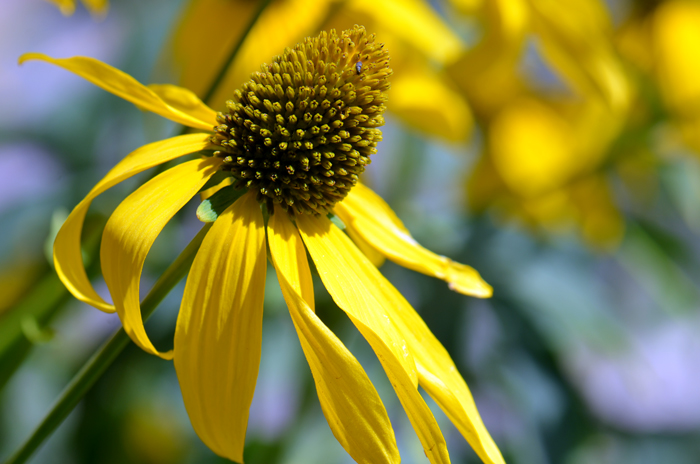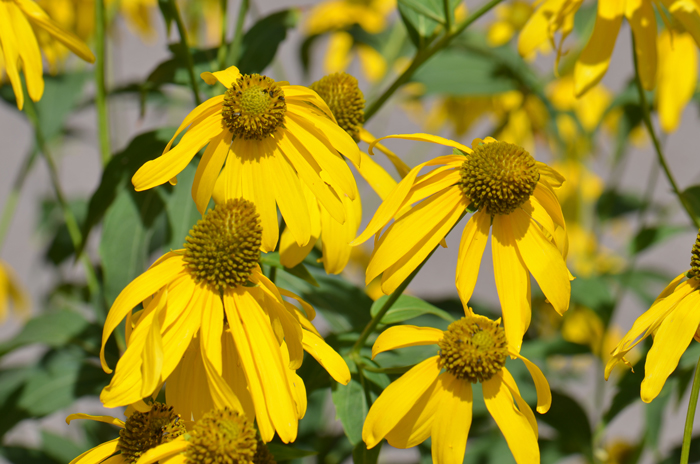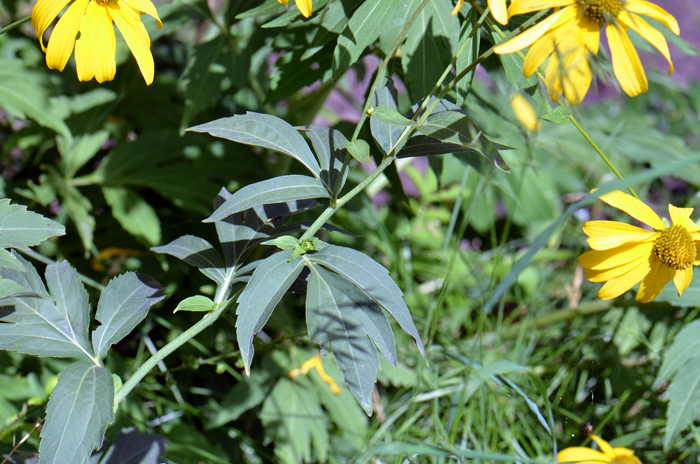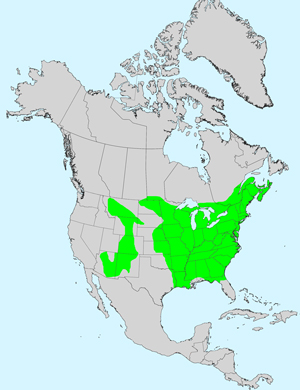Rudbeckia laciniata, Cutleaf Coneflower





Scientific Name: Rudbeckia laciniata
Common Name: Cutleaf Coneflower
Also Called: Cutleaf, Goldenglow, Green-headed Coneflower, Tall Coneflower, Thimbleweed, Wild Goldenglow
Family: Asteraceae, Sunflower Family
Synonyms: (Rudbeckia laciniata var. gaspereauensis, Rudbeckia laciniata var. hortensis)
Status: Native
Duration: Perennial from rhizomes.
Size: 6 to 8 feet ( m) Up to 9 feet (2.7 m) tall not uncommon.
Growth Form: Forb/herb, subshrub; plants upright (erect); colonial; mostly hairless (glabrous), branching along upper stems; large sunflower like flowers; plants colonial from rhizomes in moist areas.
Leaves: Dark green, showy; leaves ovate to lanceolate; alternate; deeply pinnately divided into several lobes; leaf edges or margins variable, from entire to dentate.
Flower Color: Yellow, showy large sun-flower-type heads; 2 inches (5 cm) or more across, flowering heads in branching clusters of 2 to 25; flower heads with both ray and disk florets, the ray florets are yellow while the disk florets are yellowish-green; fruit is a cypsela.
Flowering Season: July and August to September and October
Elevation: 5,000 to 9,000 feet (1,524-2,743 m)
Habitat Preferences: Higher elevations, sunny or light shade areas, rich moist soils, wetlands and along streams.
Recorded Range: Throughout most of North America; absent in CA, NV, OR.
North America & US County Distribution Map for Rudbeckia laciniata.
North America species range map for Cutleaf Coneflower, Rudbeckia laciniata:

U.S. Weed Information: Unknown
Invasive/Noxious Weed Information: Unknown
Wetland Indicator: Rudbeckia laciniata has the following wetland designations:
FACW = Facultative Wetland, usually occur in wetlands, but may occur in non-wetlands
FAC = Facultative, occur in wetlands and non-wetlands
Threatened/Endangered Information:The State of Rhode Island has listed Rudbeckia laciniata, Green-headed Coneflower as a Threatened species. Genus Information: 22 species in Rudbeckia throughout the United States and Canada. 5 varieties in Rudbeckia laciniata, 2 varieties in Arizona; Rudbeckia laciniata var. ampla, Cutleaf Coneflower and Rudbeckia laciniata var. laciniata, also Cutleaf Coneflower. Genus Information: In North America there are 22 species and 41 accepted taxa overall for Rudbeckia. Worldwide, The Plant List includes 25 accepted species names and a further 53 scientific names of infraspecific rank for Rudbeckia.
The genus Rudbeckia was published in 1753 by Linnaeus, Carl, (1707-1778).
In the Southwestern United States: Arizona has 1 species of Rudbeckia, California has 5 species, Nevada has 1 species, New Mexico has 4 species, Texas has 11 species, Utah has 5 species. Data approximate and subject to revision.
There are 5 varieties in Rudbeckia;
Rudbeckia laciniata var. ampla, (AZ, CO, ID, MT, ND, NM, SD, UT, WY; BC);
Rudbeckia laciniata var. bipinnata, (MA, MD, NH, NY, PA);
Rudbeckia laciniata var. digitata, (AL, FL, GA, KY, MD, NC, NJ, TN, SC, VA);
Rudbeckia laciniata var. heterophylla, (FL);
Rudbeckia laciniata var. laciniata, (US, absent in CA, NV, OR, UT; MB, ON, QC).
Comments: Cutleaf Coneflower responds well to summer rains in Arizona. It is common throughout the United States and Canada and is cultivated in home landscaping and by state highway departments for roadside restoration and beautification projects. In cool wet habitats, because of prolific rhizome spread, Cutleaf Coneflower should only be planted in very large landscape areas.
May be confused with Upright Prairie Coneflower, Ratibida columnifera.
Cutleaf Coneflower is considered poisonous to livestock, a factor which often leads to "weed" designation status.
The genus Rudbeckia was published in 1753 by Linnaeus, Carl, (1707-1778).
The species epithet “laciniata” (lacinia'ta:) torn or deeply cut, referring to the fringed petals and/or leaves.
See ethno-botanical uses at Native American Ethnobotany, University of Michigan, Dearborn.

